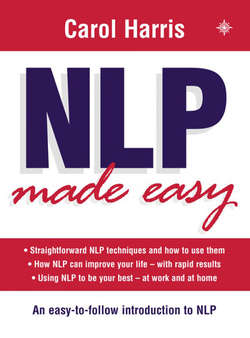Читать книгу NLP Made Easy - Carol Harris - Страница 26
It works with both the conscious and the unconscious mind
ОглавлениеThe terms ‘conscious’ and ‘unconscious’ have been used in various parts of this book. The state of consciousness is generally recognizable as an awareness of oneself or elements in one’s environment (or beyond).
The term ‘unconscious’ is commonly applied to states such as sleep, anaesthesia or fainting, but can also be used to describe mental processes that are ‘out of awareness’. These ‘out-of-awareness’ processes can include a wide range of things; for example having a mannerism of which one is not consciously aware, becoming familiar with a language simply by being exposed to hearing it rather than consciously taking time to learn the words or grammar, or responding to something in an automatic way without being aware of why that is happening (for example considering a person attractive because the pupils of their eyes are dilated, but not being aware that that fact is influencing your reaction).
Although there are differing views on how, or whether, unconscious processes actually exist (they could simply be pre-programmed behaviour rather than evidence of an ‘unconscious’ part of the mind), there is a general acceptance that the unconscious mind does exist and has a powerful influence on our attitudes and behaviour. This influence may be either positive or negative, resulting in behaviour which either achieves beneficial results or hinders them. The recognition of the influence of the unconscious mind informs much of NLP’s work, so that, although it is possible to use NLP to work solely at a conscious level, for example to break down a skill into concrete parts in order to teach it, it is probably most effective when it integrates conscious/unconscious processing. For example, when teaching a skill to people who believe that they will find it hard to learn, it is possible to manage the process of teaching so that it incorporates elements which reach the unconscious mind and are directly absorbed by the learner at a deep level.
A note of caution should be added here. Because some techniques appear to work directly at an unconscious level, bypassing conscious awareness, they could be open to misuse or could inadvertently cause undesirable results. Such techniques should therefore only be used after sufficient training and with the safeguards of respect and concern for the person who is ‘on the receiving end’. For this reason, certain techniques have only been described in outline in this book, so that they will not be practised without sufficient guidance and skill.
